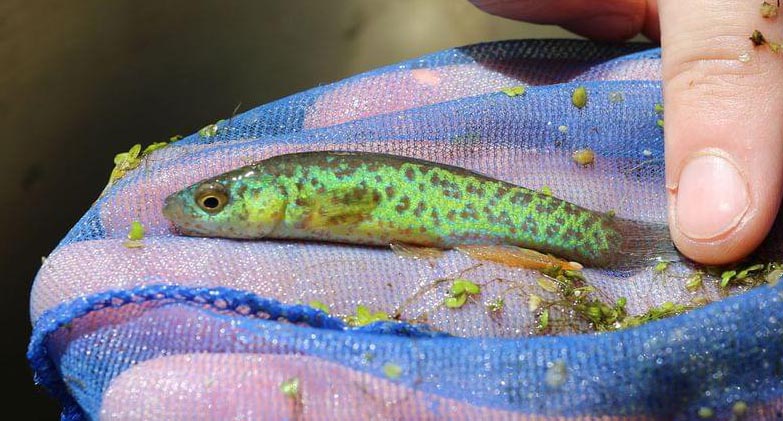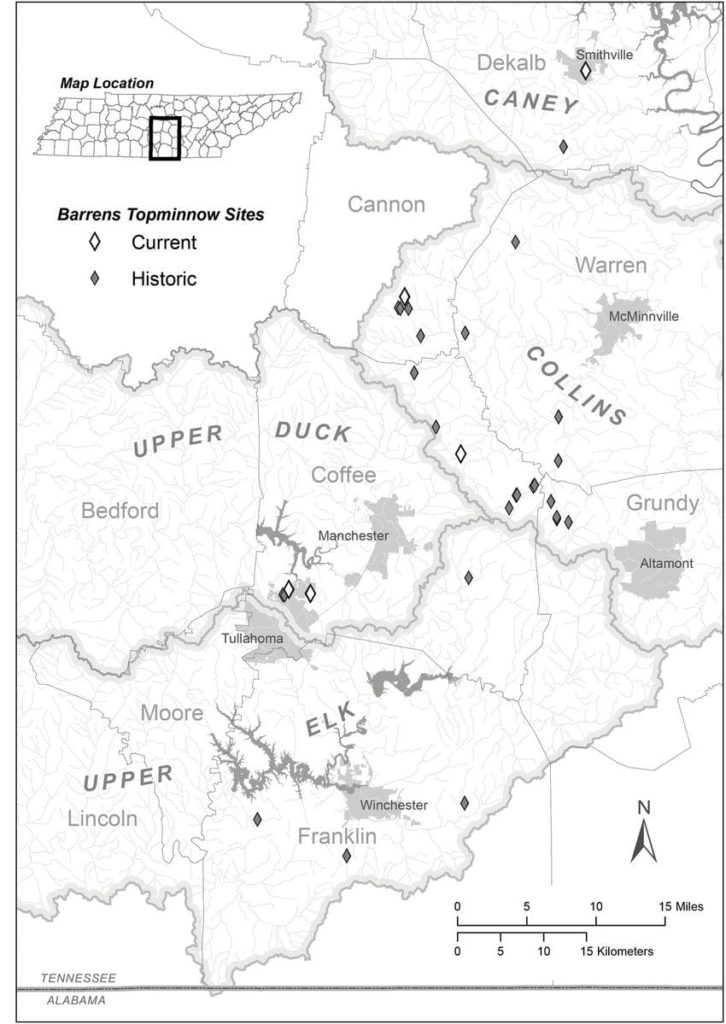
The Barrens Topminnow, Fundulus julisia, is proposed to be an endangered species. Image: Emily Granstaff, USFWS.
via US FWS
The Barrens Plateau is home to a beautiful, iridescent fish that rarely grows longer than four inches and is found in only a few creeks and springs in four Tennessee counties. That little fish is now in trouble, and the U.S. Fish and Wildlife Service is proposing to help protect it as an endangered species under the Endangered Species Act (ESA).
The Barrens topminnow has suffered from the introduction of the non-native western mosquitofish, which has invaded the minnow’s habitat, outcompeting it for food and directly preying on young topminnows. That and the impact of drought mean the minnow is struggling to survive.
“There has already been a good deal of successful conservation work on the Barrens topminnow by many partners including the Barrens Topminnow Working Group, Conservation Fisheries Inc., and the Tennessee Aquarium in Chattanooga,” said Leopoldo Miranda, assistant regional director for the Service’s Ecological Services program in the Southeast Region. “Extending protected status is a signal that more work is needed, and we look forward to cooperating with the many organizations and people trying to help this fish.”
Efforts to recover the Barrens topminnow began in the 1970s and have proven successful at producing fish for stocking. In addition, the Service worked with landowners to protect and improve Barrens topminnow habitat. Starting in the 1990s, a concerted effort was made to restock topminnows into 27 springs throughout their historic range with the cooperation of many landowners.
In 2001, the Barrens Topminnow Working Group – consisting of the Service, Tennessee Wildlife Resources Agency, Tennessee Tech University researchers, and nonprofit organizations, including the Tennessee Aquarium, and Conservation Fisheries Inc. – was created to coordinate actions such as habitat improvement, propagation, and stocking. Since the initiation of the stocking program, more than 44,000 Barrens topminnows have been stocked into 27 sites. But the prevalence of the Western mosquitofish, an invasive species that preys on and harasses the topminnow, has made recovery challenging. The mosquitofish were apparently introduced into this area in the 1960s in an effort to control mosquito populations. The mosquitofish proved only moderately successful at controlling mosquitoes, but proved to be very efficient at outcompeting Barrens topminnows. Mosquitofish are able to expand their populations rapidly and move into all corners of an available body of water. Once mosquitofish move into an area where Barrens topminnows are present, topminnow reproduction essentially ceases, and their population is eliminated.
Topminnow males are showy and iridescent, with background colors of greens and blues, with reddish-orange spots and yellow fins. Females, juveniles, and non-reproductive males are more drab, with pale brown bodies sprinkled with darker spots.
The proposed endangered listing is based on recent completion of a peer-reviewed Species Status Assessment (SSA) for the fish. The SSA report can be found on the Service’s Southeast Region website and at regulations.gov under Docket No. FWS–R4–ES–2017–0094.
The Service is accepting public comments on this proposed rule received or postmarked by March 5, 2018. Comments submitted electronically using the Federal eRulemaking Portal must be received by 11:59 p.m. Eastern Time on the closing date. The Service must receive requests for public hearings in writing at this address: Tennessee Ecological Services Field Office, U.S. Fish and Wildlife Service, 446 Neal Street, Cookeville, TN, 38506 by February 20, 2018.
You may submit comments by one of the following methods:
- Electronically: Go to the Federal eRulemaking Portal: regulations.gov. In the Search box, enter FWS–R4–ES–2017–0094, which is the docket number for this rulemaking. Then, in the Search panel on the left side of the screen, under the Document Type heading, click on the Proposed Rules link to locate this document. You may submit a comment by clicking on “Comment Now!”
- By hard copy: Submit by U.S. mail or hand-delivery to: Public Comments Processing, Attn: FWS–R4–ES–2017–0094, U.S. Fish and Wildlife Service, MS: BPHC, 5275 Leesburg Pike, Falls Church, VA 22041-3803.
We request that you send comments only by the methods described above. We will post all comments on regulations.gov. This generally means the Service will post any personal information you provide.
For more information, please contact Mary Jennings, U.S. Fish and Wildlife Service, Tennessee Ecological Services Field Office, 446 Neal Street, Cookeville, TN 38506; by telephone 931–528–6481; or by facsimile 931–528–7075. Persons who use a telecommunications device for the deaf (TDD) may call the Federal Information Relay Service (FIRS) at 800–877–8339.
Contact
Phil Kloer, Public Affairs Specialist
Philip_kloer@fws.gov, (404) 679-7299
The mission of the U.S. Fish and Wildlife Service is working with others to conserve, protect, and enhance fish, wildlife, plants, and their habitats for the continuing benefit of the American people. For more information on our work and the people who can make it happen, visit fws.gov. Connect with the Service on Facebook, follow our tweets, watch the YouTube Channel and download photos from Flickr.
###







The Tennessee Aquarium has a long-standing breeding program for the Barrens Topminnow. There is a nice exhibit which displays the breeding facility. It is quite educational.